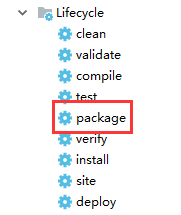Packaging and deployment of spring boot
First, packing
There are many ways to package spring boot. Some of them are war, jar, or directly submitted to github for packaging and deployment through jekins. This is mainly about how to make jar for deployment. War is not recommended, because springboot is suitable for front-end and back-end separation, so it is more suitable to build jar for deployment.
Need to add main program entry in pom.xml
<build> <plugins> <plugin> <groupId>org.springframework.boot</groupId> <artifactId>spring-boot-maven-plugin</artifactId> <configuration> <executable>true</executable> </configuration> </plugin> </plugins> </build>
-
In the idea tool, visual tools are packaged, as shown in the figure

-
Package from the command line
mvn clean package -Dmaven.test.skip=true
Two, deployment
Official website document deployment instructions
According to the above deployment, it was ruined..
Let's organize our own sh scripts
-
30. SH, this sh can be placed in the unified directory with jar
#!/bin/sh ### BEGIN INIT INFO # Provides: lanwei # Required-Start: $local_fs $network # Required-Stop: $local_fs # Default-Start: 2 3 4 5 # Default-Stop: 0 1 6 # Short-Description: XXX service # Description: XXX service ### END INIT INFO echo "Starting...." APP_NAME=$(echo $(basename $0) | sed -e 's/^[SK][0-9]*//' -e 's/\.sh$//') APP_HOME=/usr/software/${APP_NAME} #Here you need to configure the environment, dev test stg prd APP_ENV="dev" #Configure jar APP_JAR=${APP_HOME}/XXXX.jar usage() { echo "Usage: sh ${APP_NAME} [start|stop|restart]" exit 1 } ################################################## # Some utility functions ################################################## findDirectory() { local L OP=$1 shift for L in "$@"; do [ "$OP" "$L" ] || continue printf %s "$L" break done } echo "APP_ENV : ${APP_ENV}" echo "APP_HOME : ${APP_HOME}" echo "APP_NAME : ${APP_NAME}" echo "APP_JAR : ${APP_JAR}" ##################################################### # Find a location for the pid file ##################################################### if [ -z "$APP_RUN" ] then APP_RUN=$(findDirectory -w /var/run /usr/var/run /tmp) fi #APP_RUN=/var/run echo "APP_RUN : ${APP_RUN}" ##################################################### # Find a pid ##################################################### if [ -z "$APP_PID" ] then APP_PID="$APP_RUN/${APP_NAME}.pid" fi echo "APP_PID : ${APP_PID}" LOG=${APP_HOME}/logs/${APP_ENV}.log ERROR_LOG=${APP_HOME}/logs/${APP_ENV}_err.log case $1 in start) echo "Starting ${APP_NAME} ..." if [ ! -f $APP_PID ]; then cd ${APP_HOME} nohup java -jar $APP_JAR --spring.profiles.active=${APP_ENV} > $LOG 2> $ERROR_LOG & echo $! > $APP_PID echo "$APP_NAME started ..." else echo "$APP_NAME is already running ..." fi ;; stop) if [ -f $APP_PID ]; then PID=$(cat $APP_PID); echo "$APP_NAME PID is ${PID}" echo "$APP_NAME stoping ..." kill $PID; echo "$APP_NAME stopped ..." rm $APP_PID else echo "$APP_NAME is not running ..." fi ;; restart) if [ -f $APP_PID ]; then PID=$(cat $APP_PID); echo "$APP_NAME PID is ${PID}" echo "$APP_NAME stopping ..."; kill $PID; echo "$APP_NAME stopped ..."; rm $APP_PID echo "$APP_NAME starting ..." cd ${APP_HOME} nohup java -jar $APP_JAR --spring.profiles.active=${APP_ENV} > $LOG 2> $ERROR_LOG & echo $! > $APP_PID echo "$APP_NAME started ..." else echo "$APP_NAME is not running ..." echo "$APP_NAME starting ..." cd ${APP_HOME} nohup java -jar $APP_JAR --spring.profiles.active=${APP_ENV} > $LOG 2> $ERROR_LOG & echo $! > $APP_PID echo "$APP_NAME started ..." fi ;; esac
-
Create your own service name file under / etc/init.d /, such as myapp.sh
#!/bin/sh # # /etc/init.d/sms-web # chkconfig: 345 63 37 # description: activemq servlet container. # processname: activemq 5.14.1 # Source function library. #. /etc/init.d/functions # source networking configuration. #. /etc/sysconfig/network export JAVA_HOME=/usr/local/jdk1.8.0_144 export PATH=$JAVA_HOME/bin:$PATH export MYAPP_WEB_HOME=/usr/software/myapp case $1 in start) sh $MYAPP_WEB_HOME/myapp.sh start ;; stop) sh $MYAPP_WEB_HOME/myapp.sh stop ;; restart) sh $MYAPP_WEB_HOME/myapp.sh restart ;; esac exit 0
-
chmod +x myapp.sh under / etc/init.d /
-
chkconfig --list view the list of services. If not, add chkconfig --add myapp to the service.
-
Set startup chkconfig myapp on